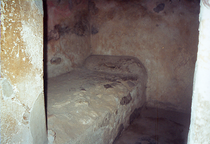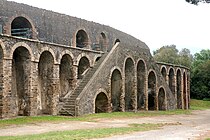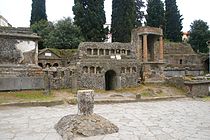Pompeii was an ancient Roman city near the present day Naples, at the mouth of the Sarno and at the foot of the Vesuvius located. A volcanic eruption caused the city to be buried, the ruins of which are now one of the most important archaeological sites in the history of the Roman Empire.

background
On August 24, 79 AD. Vesuvius erupted and covered the centuries-old Roman city of Pompeii at its foot under a thick layer of volcanic ash and pumice stone, so that the condition of many public buildings and houses has been preserved to this day.
The city was at the end of the 7th century. B.C. founded near the mouth of the Sarno and inhabited by Oscans, Etruscans and Samnites. After the region Kampania in the 6th century B.C. The city came under the influence of the Samnites. Like the rest of the Samnite league of cities, Pompeii had to settle in 290 BC. join the Roman Empire.
In AD 62. an earthquake caused damage to buildings in the city of Pompeii. Some of the damage was still being repaired when it was in AD 79. to the devastating outbreak of the Vesuvius came. After the first phase of volcanic activity, the majority of the residents had already left the city when another eruption with ash and pumice rain definitely buried the city. From the familiar from Latin class Pliny the Younger, the nephew of the Roman writer Pliny the Elder, we have a detailed eyewitness account of the downfall of the city.
After in the 16th century The first works of art and coins had been found, the first excavations were carried out after 1738, the main aim of which was to wrest sculptures and gold and silver treasures from the ground. After initially many historical traces had been destroyed, towards the end of the 18th century. systematic conservation excavations carried out for the first time.
Today is Pompeii as Excavation site and open-air museum one of the preferred travel destinations for those interested in Roman antiquity. Unfortunately, in recent years, earthquakes, weathering, precipitation and vandalism have repeatedly caused damage to the ancient substance, with the maintenance of which the chronically underfunded antiquities authority is overwhelmed in terms of personnel and finances. Parts of the excavation site are therefore closed to visitors.
getting there
By plane
The closest airport is the 1 Naples airport(IATA: NAP).
By train
From Naples with the Circumvesuviana on the line Naples - Sorrento, 2 Circumetna Pompei - Villa dei Misteri, Rides every 30 minutes, duration about 45 minutes. Return ticket price (as of November 2011): € 2.80. The entrance to the archaeological park Porta Marina is approx. 50 m from the train station. Not suitable for wheelchair users because of the steps up to the forum.
From Naples also with the Circumvesuviana on the line Naples - Poggiomarino to the stop 3 Circumetna Pompei - Santuario or from the train station 4 Stazione FS Pompei at the line Naples - Salerno the Trenitalia to the entrance at the Piazza Anfiteatro the walk is a little longer.
By bus
In the street
From the autobahn ![]() Naples - Salerno - Reggio di Calabria The Pompeii excavation site is right off of the
Naples - Salerno - Reggio di Calabria The Pompeii excavation site is right off of the ![]() Pompei Ovest reachable. Quite expensive paid parking is available to the west near the entrance to the Parco archeologico at the Porta Marina.
Pompei Ovest reachable. Quite expensive paid parking is available to the west near the entrance to the Parco archeologico at the Porta Marina.
mobility

You can walk around the excavation site. However, walking the ancient Roman roads is tiring, especially in the heat of summer.
A visit to Pompeii is only partially suitable for strollers and wheelchair users, as well as people with walking difficulties. From the east entrance on the Piazza Anfiteatro a wheelchair-accessible path is excellent.
Tourist Attractions
Scavi di Pompei, Via Villa dei Misteri 2. Open: 8.30am-7.30pm (-17: 00 November 1st-March 31st), ticket office closes at 3.30pm / 6pm.Price: 15 € adult, 2 € EU citizens between 18-25 years and free entry for <18 years (as of 09/2019); (As of Feb 2019) 20.00 / 10.00 €, three-day pass for all 5 archaeological sites, audio guide depot 5.00 €.
Suggestion for a tour starting from the entrance at the Porta Marina:

- The Via Marina (in plan yellow) (located in the Via dell'Abbondanza continues, which runs through the city in a west-east direction) leads through the city gate 1 Porta Marina past the remains of the 2 Venus Temple (Tempio di Venere) and the 3 Basilica to the right and the ruins of the 4 Temple of Apollo (Tempio di Apollo) from the 2nd century BC. to the open space of the 5 Forums. A large part of public life had taken place in this square.
- On the north side of the forum are the ruins of the 6 Jupiter Temple (Tempio di Giove), on the east side the representative one 7 Eumachia building and north that 8 Macellum. The market activities previously held at the forum have been relocated to this building.
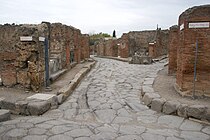
- On the Via del Foro (in plan pink) one arrives at the 9 Via delle Termewhich one follows to the west and on the Via Consolare got. Through the city gate 10 Porta di Ercolaneo in the northwest you get to the 11 Via delle Tombe along impressive monumental tombs to villas outside the city walls, of which above all the 12 Villa dei Misteri is to be mentioned. Many rooms of the villa are painted with frescoes, a representation of the Dionysian Mysteries gave the building its name.

- In the northeast quarter between the Via Consolare, the one running in west-east direction Via della Fortuna (in plan black) and the 13 Via del Vesuvio (in plan red) lies in the so-called Region VI a residential area with simple houses, shops and food stalls and in between also representative buildings, residential houses with an inner courtyard, which are often furnished with more or less tasteful frescoes.
- In the 14 Casa del Poeto tragico, the house of the tragedy poet with a representation of a theater rehearsal, there is also the famous mosaic Cave canem (Beware of the dog ...). The 15 Casa della Fontana piccola comes up with a little nyphaeum with a fountain. They are further along the road 16 Casa del Meleagro and the 17 Casa di Apollo with frescoes depicting the life of Apollo. A statue of Apollo and a faun hunting deer has been placed in the archaeological museum after Naples spent.
- They are in the parallel street 18 House of the Faun (Casa del Fauno) with a bronze statue of a faun in the impluvium, which also houses the famous Alexander mosaic with the representation of the battle between Alexander the great and Darius (today also in the museum in Naples) was found. That's one block away 19 House of the Vettier (Casa dei Vettii). In the rather modest building, a hall with particularly carefully executed paintings, especially erotic representations, stands out.
- The Via Vesuvio ends at the northern city wall at a tomb and the water supply systems. Fountains with original gargoyles can be found everywhere along the main streets.
- In the residential areas there are always shops (with a small sales and storage room in the basement), bakeries with impressive flour mills and ovens and cookshops with their sales counters with holes in which the containers with the goods were.

- Of the 20 crossing goes the Via Nola (in plan blue-violet) between areas that have not yet been exposed to the east of the 21 Porta Nola from.
- The Via Stabiana (in plan red) runs as a continuation of the Via del Vesuvio south. Past the 22 Terme Stabiane with spacious changing rooms, warm and hot baths and a swimming pool. The 23 Lupanar, the old Roman brothel with obscene paintings, price information and the prostitutes' workplaces is close by on a side street.
- A little south you get to the theater district. To the north of the theater is a 24 Isis sanctuary (Tempio d'Isis). The place of worship for the Egyptian deities was in the 2nd century BC. built. To the east of it is a presumably Asclepius shrine.
- That is to the south 25 Great theater (Teatro grande) with a portico in front. The original theater was built in Augustan times and especially after the earthquake of 62 AD. remodeled. That is right next to it 26 Small theater (Piccolo Theater) or Teatrum tectum, which was covered and could probably also be used for meetings.
- That closes in the west Forum triangolare on, which probably served as a sports facility before the construction of the great palaestra and on which a sanctuary was also built.

- On the Via dell'Abbondanza (in plan green) one arrives at the quarter with the amphithater along further residential and commercial buildings
- In the Casa della Nave Europe A graffito was found next to storage vessels with remains of food, which depicts a ship with the name "EUROPA". At that time the name of a mythical figure and not yet that of a continent.
- The Vicolo dei Fuggiaschi leads to 27 Orto the Fuggiaschi (Orto dei Fuggiaschi). Here there are plaster casts of refugees who were overtaken by the ash rain and desperately sought protection. The caves formed by the bodies in the volcanic material were preserved after their disintegration and the archaeologists were able to fill them with plaster cast material.

- In the southeast of the city is the huge sports field surrounded by a pillared hall 28 Palestra grande and right next to it the huge amphitheater, which was prepared for gladiator and animal fights. Because of inscriptions in the city, even the "theater program" with the names of the participating gladiators is known.
- Another one can be found near the city wall on the southeast corner with its defensive towers 29 necropolis (Necropoli), an area with monumental tombs.
- From there you return through the Porta Nocera on the Via Nocera on the main street Via dell'Abbondanza back which to Forum and continues to the Porta marina.
activities
- Pompeiin (guided tours). Tel.: 39 3284134719, Email: [email protected].
shop
There is a small bookshop at the entrance with books, postcards and souvenirs. Souvenirs are also offered in the fast-food restaurant near the forum.
kitchen
There is a small, clean fast food restaurant with reasonable prices near the forum.
nightlife
The excavation area is closed in the evening. The nightlife is more likely to take place in the modern town Pompei instead, with many visitors after Naples or Salerno will return.
accommodation
There are no accommodations in the excavation area itself, but there are several hotels in the modern town of Pompei.
- Campsite Zeus, Villa dei Misteri. Tel.: 39 081 8615320, Fax: 39 081 8617536, Email: [email protected]. Near the western entrance at Porta Marina.
Practical advice
Information is available at the entrances Porta Marina, Piazza Esedra and Piazza Anfiteatro.
The wild dogs are simply part of the Pompeii excavation area. They can be sponsored. But the dogs are not ownerless.
When making trips to the excavation area, make sure you wear good hats and sun protection, as the sun mercilessly heats up the ruins. Drinking water fountains are available on the premises, drinks can only be bought in a cafe on the premises.
trips
- For those interested in archeology, visit the "sister city", which was also submerged during the volcanic eruption of Vesuvius Herculaneum, the Villa di Poppea in Oplontis, today's Torre Annunziatawho have favourited Villas of Stabiae in today's Castellammare di Stabia and the Roman villa in Boscoreale.
- Not far away are the huge excavations of the Greek temples of Paestumwhich via the autobahn after Salerno are within reach.
- Visit of Amalfi coast
literature
Web links
- http://www.pompeiisites.org/ - Official website of Pompeii in Italian (with interactive map) and English.
- The List of buildings In Pompeii the WP helps to find one's way around the city and to find buildings and frescoes of particular interest.
- Website of the Phoenix Pompeii cultural initiativewhich is currently raising funds for canopies. They are supposed to protect the tombs of the necropolis in front of the Porta Nocera in Pompeii.

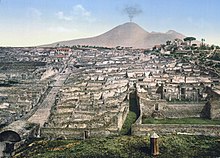






























.jpg/210px-Pompeii_-_Cave_Canem_(4786638740).jpg)







_-_n._1210_-_Pompei_-_Casa_del_Poeta.jpg/297px-Sommer,_Giorgio_(1834-1914)_-_n._1210_-_Pompei_-_Casa_del_Poeta.jpg)

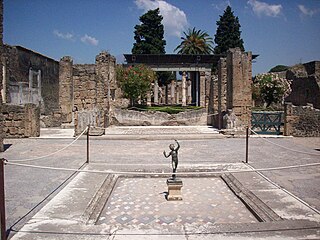
_01.JPG/320px-Ricostruzione_del_giardino_della_casa_dei_vetii_di_pompei_(mostra_al_giardino_di_boboli,_2007)_01.JPG)
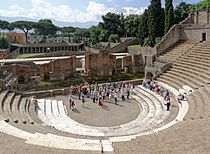
_in_Pompeji.JPG/210px-Theatro_Piccolo_(Odeion)_in_Pompeji.JPG)


